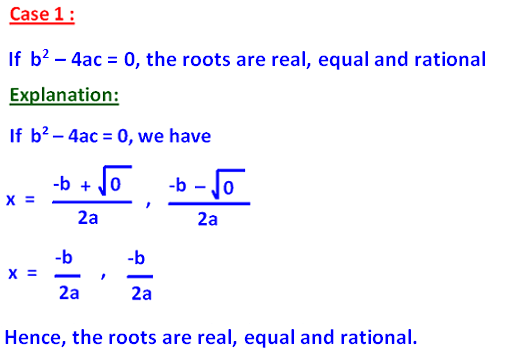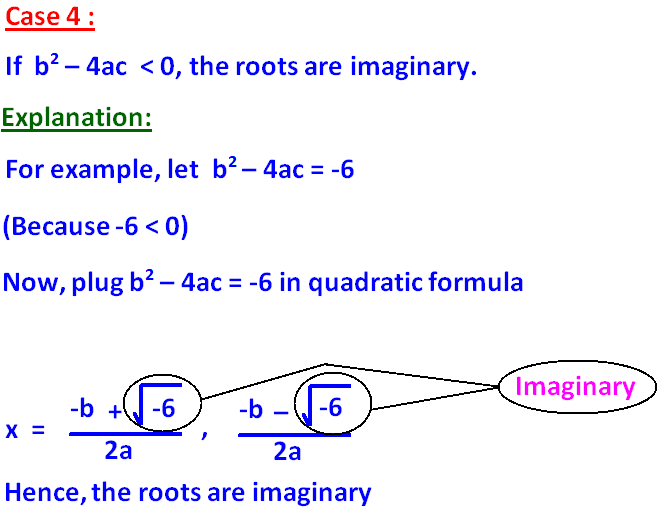PROPERTIES OF QUADRATIC EQUATIONS
1. The zeros of a quadratic function f(x) = ax2+ bx + c are nothing but the two values of 'x' when
f(x) = 0 or ax2 + bx + c = 0
Here, ax2 + bx + c = 0 is called quadratic equation.
Finding the two zeros of a quadratic function or solving the quadratic equation are the same thing.
2. The standard form of a quadratic equation is
ax2 + bx + c = 0
3. There are three methods to find the two zeros of a quadratic equations.
They are,
(i) Factoring
(ii) Quadratic formula
(iii) Completing square
4. If the two zeros of a quadratic equation are irrational, then the two zeros (roots) will occur in conjugate pairs. That is, if (m + √n) is a root, then (m - √n) is the other root of the same equation.
5. The sum of the zeros of the quadratic equation in standard form ax2+ bx + c = 0 is -b/a.
6. The product of the zeros of the quadratic equation in standard form ax2+ bx + c = 0 is c/a.
7. If two zeros of a quadratic equation ax2+ bx + c = 0 are reciprocal to each other, then their product is 1 or
c = a
8. If two zeros of a quadratic equation ax2+ bx + c = 0 are equal in magnitude, but opposite in sign, then their sum is equal to zero or
b = 0
9. If we know the two zeros of a quadratic equation, the formula given below can be used to form the quadratic equation.
x2 - (Sum of the roots)x + product of the roots = 0
10. The graph of any quadratic equation will be a parabola. In f(x) = ax2 + bx + c, if a > 0, the parabola opens up and if a < 0, the parabola opens down.
11. The zeros of a quadratic equation are the x-coordinates of the points where the parabola (graph of quadratic a function) cuts x-axis.

12. If the two zeros of a quadratic equation are imaginary, then the graph (parabola) will never intersect x - axis.
13. The two x-intercepts of a parabola (graph of a quadratic function) are the zeros of the quadratic equation.
14. x- coordinate of the vertex of the parabola is -b/2a and the vertex is (-b/2a, f(-b/2a)).
15. To know at where the parabola cuts y-axis or y-intercept of the parabola, we have to plug x = 0 in the given quadratic function.
16. The discriminant b2 - 4ac discriminates the nature of the zeros of the quadratic equation ax2 + bx + c = 0.
Let us see how this discriminant 'b2 - 4ac' can be used to know the nature of the roots of a quadratic equation.







Apart from the stuff given above, if you need any other stuff in math, please use our google custom search here.
Kindly mail your feedback to v4formath@gmail.com
We always appreciate your feedback.
©All rights reserved. onlinemath4all.com
Recent Articles
-
SAT Math Resources (Videos, Concepts, Worksheets and More)
Dec 17, 24 10:13 AM
SAT Math Resources (Videos, Concepts, Worksheets and More) -
Digital SAT Math Problems and Solutions (Part - 88)
Dec 17, 24 10:07 AM
Digital SAT Math Problems and Solutions (Part - 88) -
Logarithmic Equations Problems and Solutions
Dec 15, 24 08:14 AM
Logarithmic Equations Problems and Solutions
